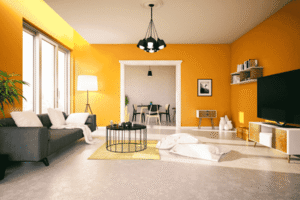Proper setup of a 3D printer is essential for maximizing its performance at home. A sturdy enclosure supports your 3D printer, allowing it to work safely, quietly, and steadily. Home experimentation is a standard practice in the quest for economical enclosure options. The result is a standout solution with an IKEA Lack table and plexiglass. It’s easy to make, inexpensive, and works great. If you’re looking for an easy method to control your 3D printer, this enclosure setup is highly recommended.
Why Enclosures Matter More Than You Think
Open 3D Printers, despite having an impact that may seem desirable, tend to encounter significant challenges. Wind, dust particles, and temperature changes can significantly impact the quality of your prints. Windy fans and the movement of parts may distract others around you. Problems associated with enclosures can be fixed with a well-designed enclosure. It provides your printer with a stable and secure environment in which to operate. A well-organized printer will produce better prints and minimize messes for guaranteed consistency. An enclosure can improve safety and efficiency when using your 3D printer.
The IKEA Lack Table: A DIY Favorite
Many homes have the IKEA Lack table. It comes complete with a low weight, tremendous durability, and is quite economical too. First off, makers saw its adaptability. Piling up two IKEA Lack tables is the best arrangement. Since the sides are open, it is possible to add walls at any given time. The table’s size and shape are most preferable for a great number of popular desktop 3D printers.
Adding Plexiglass for a Clear, Clean Finish
Plexiglass is the material of choice for adding enclosure sides. It is easy to cut and handle and has a sleek appearance. You can see your prints from outside without opening the table. This means the overall presentation is sharp and stylish, and temperate regulation has improved. Plexiglass helps prevent rapid cooling caused by outside airflow. It helps maintain uniform temperatures and yields better printout results. The IKEA Lack, combined with plexiglass, makes for an ideal enclosure.
Simple Tools, Big Results
This build is available even without specialized tools and complex techniques. To complete most of the work, you will need a drill, a measuring tape, and screws. For this project, you will need only basic tools for plexiglass cutting. Consider mounting one side with a door that opens on hinges or with magnets. If you like, you can add handles or vents to the enclosure. There is no shortage of tutorials and guides available on the internet. Even someone with little to no experience in 3D printing can assemble the setup over the weekend. You will enjoy the process and come out with a functional, meaningful result.
How It Helps with Print Quality
Proper control of temperature is essential to work with ABS or nylon. Prints are prone to warping if they cool down too fast. Adding Plexiglass to an IKEA Lack is an excellent solution to this problem. It retains heat and keeps an even temperature while printing. Consequently, there is an interval during which the likelihood of error is lower, and prints appear smoother. Many users have reported enhanced bed adhesion and layer shift reduction effects. Your printer is enclosed, thereby creating a simulated constant print environment that increases your print reliability.
Noise Control Is a Bonus Benefit
3D printers make more noise when placed in close quarters. Most of the noise is attributed to the numerous moving parts, such as fans and motors. With the enclosure, you will hear the noise from the printer much less. A lot of annoying buzzing and humming is covered up by the plexiglass enclosure. Through the use of foam or dampeners, quieter prints become even more possible. Using the enclosure, you can print even through the night without upsetting your sleep. Fewer noise means that your neighbors are less troubled when you print.
A Cleaner, Safer Setup
A solution for keeping your printer dust and accident-proof is an enclosure. Inattentive kids, pets, or tangled wires could also get into trouble if your printer is left uncovered. At the same time, the IKEA Lack setup gives your printer a shield that protects it from harm. You will not have to come in the morning wondering if I have a pet or if someone’s hand bumped my printer and caused chaos. It’s easy for you to maintain a tidier environment. With an enclosure, you can minimize the risk of dust accumulation and contain the mess caused by the filament. The vicinity is better suited for children or the local area.
Conclusion: Smart, Stylish, and Functional
There is nothing that will give you a better idea of a DIY project than combining an IKEA Lack enclosure and plexiglass. This arrangement is cost-effective, user-friendly, and performs as intended. It enhances print outcomes, lowers noise, and protects your printer. This enclosure is highly sought after by many due to its primary advantages. This configuration works whether you are new to 3D printing or a seasoned professional. It has a pleasing geometry, excellent performance, and useful elements. After a minimal time, you will have a system that will last years.
- DIY 3D Printer Enclosure with IKEA Lack and Plexiglass for Better Prints
- Build a cost-effective 3D printer enclosure using the IKEA Lack table and plexiglass. Improve print quality, reduce noise, and enhance safety with this easy DIY setup.
- ikea lack enclosure plexiglass
Related posts:
 Why KBH Games Is Perfect for Family-Friendly Online Entertainment
Why KBH Games Is Perfect for Family-Friendly Online Entertainment
 Build a Seamless School Portal with These Powerful Templates
Build a Seamless School Portal with These Powerful Templates
 The Ultimate Web Development Checklist for Building High-Performance Digital Experiences
The Ultimate Web Development Checklist for Building High-Performance Digital Experiences
 How Ecommerce ERP Transforms Inventory and Order Management – Rholab
How Ecommerce ERP Transforms Inventory and Order Management – Rholab
 Benefits of AI-powered CCTV Cameras for Business Surveillance
Benefits of AI-powered CCTV Cameras for Business Surveillance
 Top App Development Agency UK – Transforming Ideas into Apps
Top App Development Agency UK – Transforming Ideas into Apps
 Transforming Oil and Gas Operations in Qatar with Microsoft Dynamics 365 Supply Chain Management
Transforming Oil and Gas Operations in Qatar with Microsoft Dynamics 365 Supply Chain Management
 How Modern Cars Are Turning to Tech Experts to Solve Connectivity Chaos
How Modern Cars Are Turning to Tech Experts to Solve Connectivity Chaos







